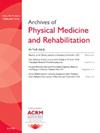慢性中风意向驱动机器人手训练后上肢运动恢复的运动意向综合预测模型的开发和外部验证
IF 3.6
2区 医学
Q1 REHABILITATION
Archives of physical medicine and rehabilitation
Pub Date : 2025-02-01
DOI:10.1016/j.apmr.2024.08.015
引用次数: 0
摘要
目的:利用受影响上肢的残余自主肌电信号,推导并验证意向驱动机械手训练后上肢运动功能最小临床重要差异(MCID)的预测模型:设计:一项前瞻性纵向多中心队列研究。我们收集了干预前的候选预测因素:人口统计学、临床特征、Fugl-Meyer UE 评估(FMAUE)、行动研究手臂测试评分,以及最大自主收缩(MVC)时通过肌电图测量的屈指肌和伸指肌(ED)的运动意向。在肌电图测量中,考虑到中风幸存者在移动瘫痪手时面临的挑战,我们从最大自主收缩过程中的八个时间窗口(0.1 秒至 5 秒)中提取峰值信号,以识别受试者的运动意向。采用分类和回归树算法预测幸存者的运动意向,MCID 为 FMAUE。进一步研究了预测因子与运动改善之间的关系:九个康复中心:慢性中风幸存者(131 人),其中 87 人为推导样本,44 人为验证样本:干预措施:所有参与者接受 20 次机器人手训练(40 分钟/次,3-5 次/周):通过接收者操作特征曲线下面积(AUC)评估模型的预测效果。最佳有效模型为最终模型,并通过AUC和总体准确性进行验证:最佳模型由 FMAUE(截断分数:46)和一秒 MVC-EMG 的 ED 峰值活动(MVC-EMG 比静息-EMG 高 4.604 倍)组成,其预测准确率(AUC:0.807)明显高于其他时间窗口或仅使用临床评分(AUC:0.595)。在外部验证中,该模型显示出强大的预测能力(AUC:0.916)。在 ED-EMG 和 FMAUE 的增加之间观察到了显著的二次关系:本研究提出了慢性中风幸存者意向驱动机器人手训练的预测模型。它强调了通过 1 秒肌电图窗口捕捉运动意向作为 20 次机器人训练后 UE 运动功能 MCID 改善的预测因子的重要性。在两种情况下,幸存者的临床运动改善比例较高:中度至高度运动意向和低度至中度功能;以及高度意向和高度功能。本文章由计算机程序翻译,如有差异,请以英文原文为准。
Development and External Validation of a Motor Intention–Integrated Prediction Model for Upper Extremity Motor Recovery After Intention-Driven Robotic Hand Training for Chronic Stroke
Objective
To derive and validate a prediction model for minimal clinically important differences (MCIDs) in upper extremity (UE) motor function after intention-driven robotic hand training using residual voluntary electromyography (EMG) signals from affected UE.
Design
A prospective longitudinal multicenter cohort study. We collected preintervention candidate predictors: demographics, clinical characteristics, Fugl-Meyer assessment of UE (FMAUE), Action Research Arm Test scores, and motor intention of flexor digitorum and extensor digitorum (ED) measured by EMG during maximal voluntary contraction (MVC). For EMG measures, recognizing challenges for stroke survivors to move paralyzed hand, peak signals were extracted from 8 time windows during MVC-EMG (0.1-5s) to identify subjects’ motor intention. Classification and regression tree algorithm was employed to predict survivors with MCID of FMAUE. Relationship between predictors and motor improvements was further investigated.
Setting
Nine rehabilitation centers.
Participants
Chronic stroke survivors (N=131), including 87 for derivation sample, and 44 for validation sample.
Interventions
All participants underwent 20-session robotic hand training (40min/session, 3-5sessions/wk).
Main Outcome Measures
Prediction efficacies of models were assessed by area under the receiver operating characteristic curve (AUC). The best effective model was final model and validated using AUC and overall accuracy.
Results
The best model comprised FMAUE (cutoff score, 46) and peak activity of ED from 1-second MVC-EMG (MVC-EMG 4.604 times higher than resting EMG), which demonstrated significantly higher prediction accuracy (AUC, 0.807) than other time windows or solely using clinical scores (AUC, 0.595). In external validation, this model displayed robust prediction (AUC, 0.916). Significant quadratic relationship was observed between ED-EMG and FMAUE increases.
Conclusions
This study presents a prediction model for intention-driven robotic hand training in chronic stroke survivors. It highlights significance of capturing motor intention through 1-second EMG window as a predictor for MCID improvement in UE motor function after 20-session robotic training. Survivors in 2 conditions showed high percentage of clinical motor improvement: moderate-to-high motor intention and low-to-moderate function; as well as high intention and high function.
求助全文
通过发布文献求助,成功后即可免费获取论文全文。
去求助
来源期刊
CiteScore
6.20
自引率
4.70%
发文量
495
审稿时长
38 days
期刊介绍:
The Archives of Physical Medicine and Rehabilitation publishes original, peer-reviewed research and clinical reports on important trends and developments in physical medicine and rehabilitation and related fields. This international journal brings researchers and clinicians authoritative information on the therapeutic utilization of physical, behavioral and pharmaceutical agents in providing comprehensive care for individuals with chronic illness and disabilities.
Archives began publication in 1920, publishes monthly, and is the official journal of the American Congress of Rehabilitation Medicine. Its papers are cited more often than any other rehabilitation journal.

 求助内容:
求助内容: 应助结果提醒方式:
应助结果提醒方式:


